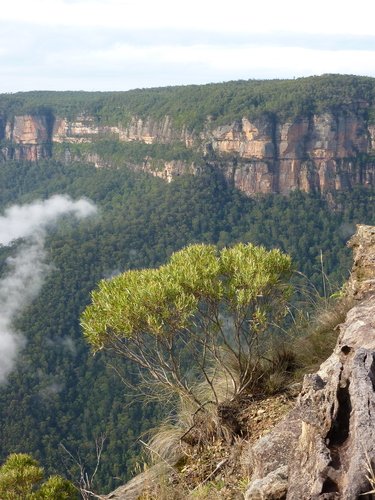Grevillea acanthifolia: Beauty and Danger in the Native Garden
We have Found success growing Grevillea acanthifolia, an endangered Blue Mountains native, despite its reputation for thriving only in boggy conditions. Surprisingly, it’s done well in drier soils. Its sharp-tipped leaves may be dangerous but the vibrant pink and purple blooms are well worth it. This plant brings a rugged beauty to the garden, showcasing the tough yet gorgeous nature of Australia's flora.
The Big Phosphorus Issue - Australian Native Plants
Using Australian native plants in the home garden is one of the true joys of gardening in our sun-baked country. However, many gardeners are often discouraged from using native plants because they have a reputation for being fussy and think they need to be kept separate from exotic plants in their garden. While this is true for some native species, many can be treated as regular garden plants. The reason they have acquired this reputation is that some native plants are sensitive to phosphorus. Understanding this distinction can make using natives in your garden easy and rewarding.
How to organically fertilise phosphorus sensitive Australian native plants
Fertilising Australian native plants has sparked debate among gardeners for years. Historically, many believed these plants didn't need fertilising due to their evolutionary adaptation to grow in nutrient-poor soils. However, this myth has been debunked; In the garden, Australian native plants benefit significantly from feeding. While chemical fertilisers often pose risks due to high phosphorus levels, organic methods offer a safer alternative. By using compost, mulches, and specific organic liquid feeds, gardeners can nourish their native plants effectively and safely.
Three reasons to love Brachyscome multifida.
These vibrant purple flowers effortlessly infuse your native landscape with immediate bursts of color and whimsy. Indigenous to New South Wales, they seamlessly complement various garden styles, radiating beauty in cottage gardens while flourishing in the untamed allure of native bush-blocks and coastal, windswept landscapes.
Mallee Eucalyptus species of the Greater Blue Mountains
Mallee Eucalyptus have an attractive and unique habit makes them perfectly suited for Australian native and mediterranean style gardens. They aretough and drought tolerant making them ideal for waterwise gardens. They attract native birds and wildlife to your garden.
Eucalyptus apiculata - Narrow-Leaved Mallee Ash - Plant Profile
The Narrow-Leaved Mallee Ash, scientifically known as Eucalyptus apiculata, is a small tree belonging to the Myrtaceae family. With a compact habit as a Mallee, it typically reaches a height of 4-6 meters and spans a width of 3-4 meters. The tree produces charming flowers in various shades including white, cream, and yellow, with recorded blooming periods in January, March, October, and December. Thriving in temperate to cool-temperate climates, this species prefers full sun exposure and exhibits moderate frost tolerance while showcasing commendable drought resistance. The Narrow-Leaved Mallee Ash is adaptable to poor soils, particularly those comprised of sandstone. Its resilience and aesthetic appeal make it a noteworthy addition to diverse landscapes.
Eucalyptus burgessiana - Faulconbridge Mallee Ash - Plant Profile
The Faulconbridge Mallee Ash, scientifically known as Eucalyptus burgessiana, is a small tree with a compact mallee habit. It typically reaches a height of up to 7 meters and spans a width of 3-5 meters. The plant is characterized by a lignotuber root system. Its flowers, appearing in white, cream, and yellow hues, bloom has been recorded in various months, including May, August, September, November, and December. Thriving in temperate climates, this species prefers full sun skeletal sand on sandstone soils with an Noteworthy for its frost tolerance and drought resistance, the Faulconbridge Mallee Ash is well-suited for garden styles inspired by Australian native or Mediterranean landscapes.
Eucalyptus cunninghamii - Cliff Mallee Ash - Plant Profile
Eucalyptus cunninghamii, commonly referred to as Cliff Mallee-ash, is a shrub to small tree Ranging from 0.5 to 2 meters in height and 1 to 4 meters in width, this species features densely held foliage atop numerous stems and roots characterized by a lignotuber. Its delicate white and green-white flowers grace the plant in recorded intervals during April, September, and December. Thriving in the natural habitat of Blue Mountains' Mallee Heath, steep slopes, and cliff edges, this resilient species is naturally restricted to cool-temperate climates on the upper Blue Mountains. It flourishes full sun and tolerates light shade, and enjoys eroded skeletal sandy soil on sandstone. Notably frost-hardy and drought tolerant.
Eucalyptus stricta - Blue Mountains Mallee Ash - Plant Profile
Eucalyptus Stricta, commonly known as the Blue Mountains Mallee Ash, is a small Mallee tree or mallee. This resilient plant, with a height ranging from 5 to 7 meters depending on the substrate, boasts a width of 3 to 5 meters. It forms roots system know as a lignotuber. The Blue Mountains Mallee Ash exhibits elegant small flowers on previous seasons growth in hues of white to cream. Thriving in temperate to cool-temperate climate zones, this species is somewhat versatile in its light requirements, flourishing in full sun and tolerating light shade. It proves to be hardy thriving in sandy, poor soils, with a preference for acidic to neutral pH levels. Notably frost-hardy, this plant showcases its hardiness in our tough australian climate.












![The Age of Pittosporum undulatum [WEED]](https://images.squarespace-cdn.com/content/v1/65527a69a4701e0bf94a24a3/d8799181-4302-436d-9d2a-167cff1f313b/Pittosporum_undulatum_flower_closeup.jpg)




